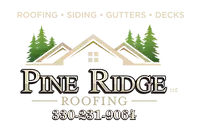East Liberty Roof Damage by Weather Conditions and Insurance Claims - A Comprehensive Guide
Your home is your sanctuary, and your roof plays a crucial role in keeping it safe and secure. But what happens when roof damage by weather conditions strikes? Understanding the types of roof damage caused by the elements, navigating the insurance claim process, and knowing how to maintain your roof can make all the difference in protecting your investment.
This comprehensive guide will walk you through everything you need to know to safeguard your home and navigate “roof damage by weather conditions and insurance claims” with confidence.
In East Liberty, Roof damage resulting from severe weather conditions like storms, high winds, tornadoes, and hail is a frequent occurrence. At Pine Ridge Roofing we are prepared to offer our support to address these issues.
Key Takeaways
Table of Contents
East Liberty Roof Damage - Types of Weather-Related Roof Damage
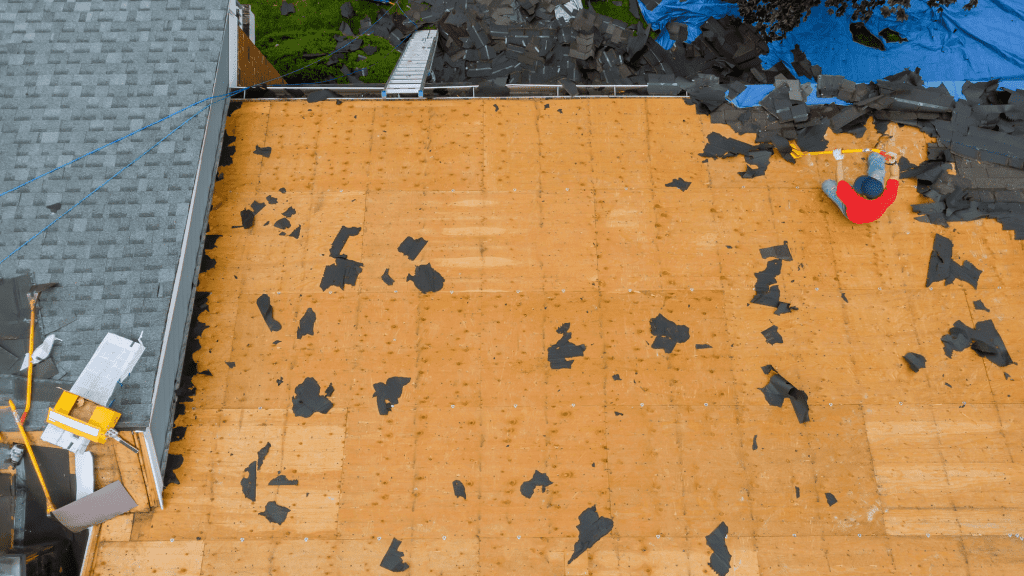
In East Liberty, roof damage by weather conditions is really common. Weather can be unpredictable, and it can wreak havoc on your roof. Wind, hail, and rain or snow are the most common culprits of weather-related roof damage, often leading to insurance claims and costly repairs or replacements.
Protecting your home requires recognizing the signs of storm damage and comprehending how these forces impact your roofing materials.
Is roof damage covered by insurance? For home insurance to provide coverage for your roof damage expenses, it is essential to establish that the damage was a direct result of an extreme weather event.
Wind Damage
In East Liberty, roof damage caused by high winds can silently jeopardize the condition of your roof. This damage may manifest as missing shingles, lifted flashing, or cracked tiles, and in severe cases, it might result in the complete displacement of the roof. Despite appearing minor initially, these damages can escalate over time, leading to leaks and structural issues that necessitate initiating the roof insurance claim process.
Repairing an older roof introduces challenges, particularly with less flexible and prone-to-cracking shingles. It is imperative to involve a qualified roofing specialist for a meticulous roof inspection and to promptly address any damage.
Gaining insight into the wind insurance coverage specifics in your homeowner’s insurance policy is pivotal for preparedness, especially during adverse weather conditions such as storms.
Wind damage can stem from various weather events, including severe storms or hurricanes. Consistently monitoring your roof’s condition post such events is essential, and taking swift action upon observing visible signs of wind damage is critical. If, for instance, a sizable tree branch is discovered on your roof, it is advisable to have it professionally removed to prevent further damage and potential roof damage claims.
Hail Damage
When a hailstorm hits, it can leave a path of destruction in its wake, causing dents, punctures, and granule loss on shingles. This type of damage might not always be visible to the untrained eye, but it can significantly impact your roof’s lifespan and performance. Hail can cause bruising or cracking of the shingle mat, allowing water to enter your home gradually and potentially leading to a roof claim.
Roof inspection for hail damage can be challenging, especially after a storm. Insurance adjusters and roofing professionals often consider metal components surrounding the roof, such as:
- Roof vents
- Pipe boots
- Gutters
- Roof flashing
Dents in these metal pieces may suggest hail damage. However, it is not recommended to go on the roof right after a storm, particularly if the roof has a steep slope.
In case of significant hail damage to your roof, immediate action is necessary, such as attaching tarps to the roof, to prevent further damage from rainwater.
Rain and Snow Damage
Rain and snow may seem harmless, but they can wreak havoc on your roof if not properly managed. Here are some potential issues caused by rain and snow:
- Leaks and water damage
- Structural issues
- Roof collapse due to the weight of accumulated snow
- Ice dams, which can damage your roof and gutters
It’s important to take steps to protect your roof from these potential problems.
Safeguarding your property from rain and snow damage requires proactive steps, including regular inspections, proper ventilation, and robust waterproofing. By actively overseeing the maintenance of your roof and comprehending homeowner’s insurance choices like Actual Cash Value (ACV) and Replacement Cost Value (RCV) policies, you can effectively minimize the risk of incurring significant costs for repairs or replacements resulting from adverse weather conditions.
East Liberty Roof Damage - Insurance Coverage for Weather-Related Issues
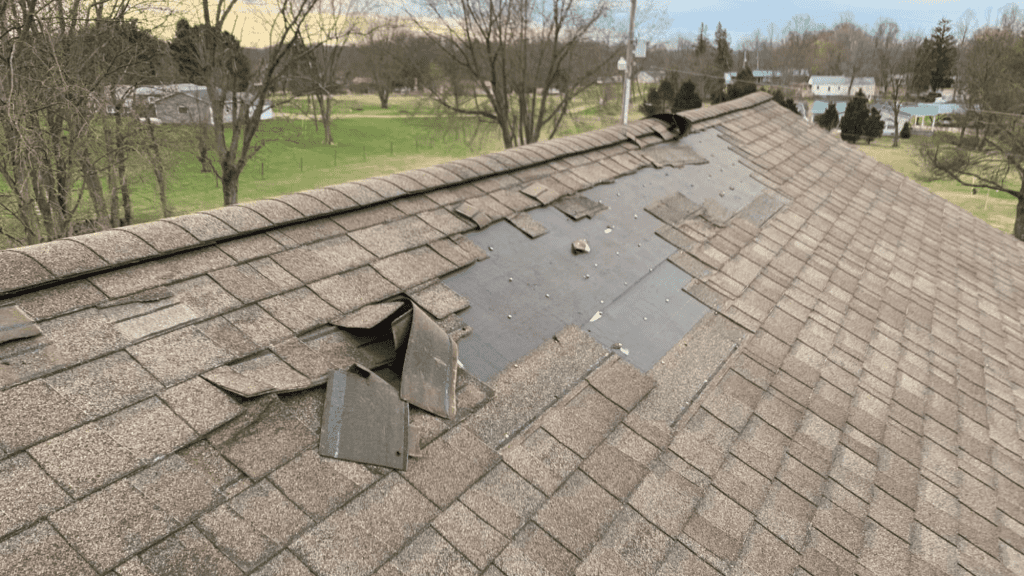
Securing your financial well-being in the face of unexpected roof damage in East Liberty, OH, hinges on the pivotal role played by the insurance company. Yet, navigating the intricate landscape of insurance coverage can be a daunting task. A thorough understanding of policy distinctions, like Actual Cash Value (ACV) and Replacement Cost Value (RCV), and a keen awareness of prevalent exclusions can exert a substantial influence on the handling and eventual resolution of your claim.
Policy Types: ACV vs RCV
When it comes to roof coverage, an Actual Cash Value (ACV) policy is designed to facilitate the replacement process by reimbursing you for the depreciated value of your roof, minus the deductible. Essentially, this means you’ll receive compensation based on the current value of your roof at the time of damage. However, it’s important to note that this might not cover the entire cost of repairs or replacement.
On the flip side, a Replacement Cost Value (RCV) policy offers more extensive coverage. It covers the entire cost of roof replacement, providing funds for a new roof based on current market prices and materials. Under an RCV policy, you’ll first receive a check for the actual cost value of your roof. After completing the roof replacement, a second check for the remaining amount will be issued, contingent upon meeting all specified requirements.
The choice of a suitable policy for your needs can greatly impact the payout you receive in the event of a roof damage claim, making it an important decision. It is essential to:
- Review your insurance policy
- Understand the differences between ACV and RCV
- Consult with your home insurance company to ensure you have the appropriate coverage for your specific situation.
Common Exclusions
Preserving your home from weather-induced roof damage in East Liberty, OH, with homeowners insurance is a wise move, but being mindful of common exclusions is equally crucial for a seamless claims process, such as:
- Improper installation, deviating from manufacturer instructions or local building codes, is a typical exclusion that can hasten wear and tear, potentially voiding your roof’s warranty.
- Neglecting routine maintenance, such as clearing gutters and removing debris, might result in damages not covered by your policy.
- Some policies may also exclude specific weather events, like hurricanes or earthquakes.
A comprehensive review of your insurance policy is essential to understand these exclusions and secure proper coverage for your roof. Inadequate maintenance occurs when regular inspections and maintenance, following manufacturer guidelines and local codes, are overlooked, possibly causing premature deterioration and voiding warranties.
Understanding these exclusions and ensuring proper roof installation, maintenance, and protection against excluded weather events are critical steps to avoid potential claim denials. Staying informed and taking a proactive approach to roof care can minimize the risk of expensive repairs or replacements due to weather-related damage.
East Liberty Roof Damage - Filing an Insurance Claim
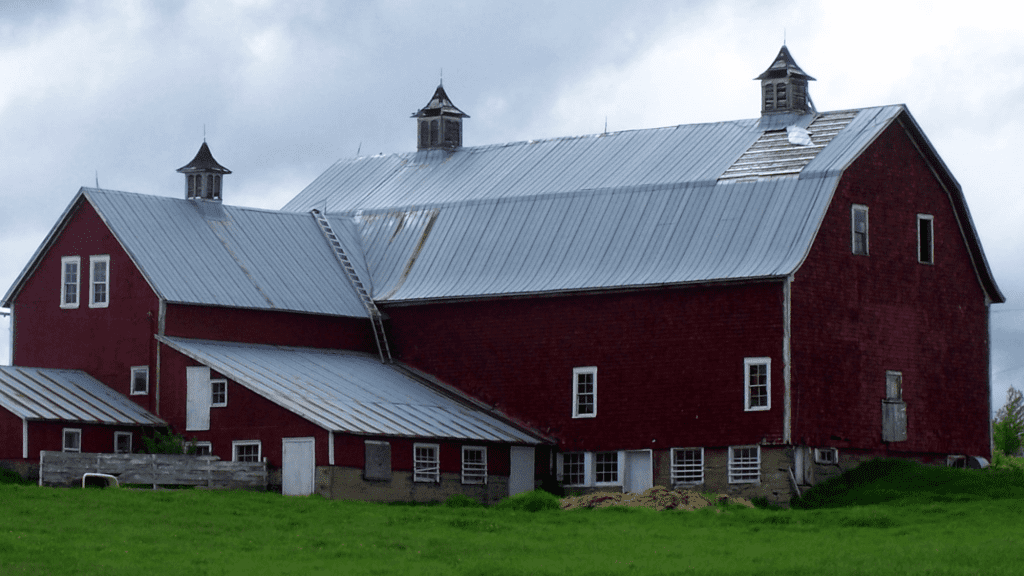
Navigating the process of filing an insurance claim for roof damage in East Liberty, Ohio requires a well-thought-out approach. From meticulous documentation of the damage to effective collaboration with insurance adjusters and making wise decisions when choosing a roofing contractor, each step is crucial for a successful claims process.
This guide provides a comprehensive overview, guiding you through the necessary steps and offering valuable tips to ensure a smooth and successful insurance claim experience for roof damage.
Documenting the Damage
Before filing an insurance claim for roofing damage, it is crucial to maintain a detailed documentation process. Follow these steps:
- Photograph the affected areas extensively, emphasizing any missing shingles, raised flashing, or damaged tiles.
- Prepare a comprehensive list of the damage, accompanied by detailed notes, including dates, times, and relevant weather conditions contributing to the damage.
- If preventive measures have been taken, such as securing tarps to the roofing, document these measures through photographs.
After documenting the damage, seek an estimate from a certified roofing contractor to assess the repair or replacement costs. This estimate not only clarifies the extent of the damage but also serves as critical documentation when presenting your claim to the insurance company. Maintaining a thorough and accurate record of the roofing damage significantly improves the chances of a successful claim.
Working with Adjusters
In East Liberty, roof damage evaluation involves the integral role of insurance adjusters in determining the value of your claim payout. Collaborating effectively with these adjusters is paramount for securing the best possible outcome for your claim. It’s crucial to provide accurate information, maintain thorough records of all interactions and pertinent documents, and uphold honesty throughout the process.
When faced with a denied claim, exploring various resolution options is essential:
- Consider asking your insurance company for a different adjuster to obtain a second opinion.
- Alternatively, engaging a structural engineer for a comprehensive inspection and evidence of the damage is a viable step.
- As a last resort, legal avenues can be pursued.
Understanding the adjusters’ role and being well-prepared to work with them increases the likelihood of a successful claim. This ensures you receive the necessary coverage to repair or replace your roof damaged in East Liberty.
Choosing a Reputable Roofing Contractor
Opting for a reputable roofing contractor is paramount to ensuring high-quality work and a seamless insurance claims process. When researching roofing contractors for insurance claims, it’s crucial to consider their experience with claims, turnaround times, and their ability to collaborate with adjusters. A competent roofing contractor excels in accurately documenting damage according to the specific requirements of insurance companies and providing expert assessments.
Choosing a local and trustworthy roofing contractor, such as Pine Ridge Roofing, provides peace of mind knowing that your roof repair or replacement is in capable hands. Their team of certified roofers and insurance specialists is prepared to assist with storm repair, restoration, and insurance claims in East Liberty, OH, and the surrounding areas. Opting for an experienced roofing contractor is a sure way to ensure the safety and integrity of your home.
East Liberty Roof Damage - Preventative Measures and Maintenance
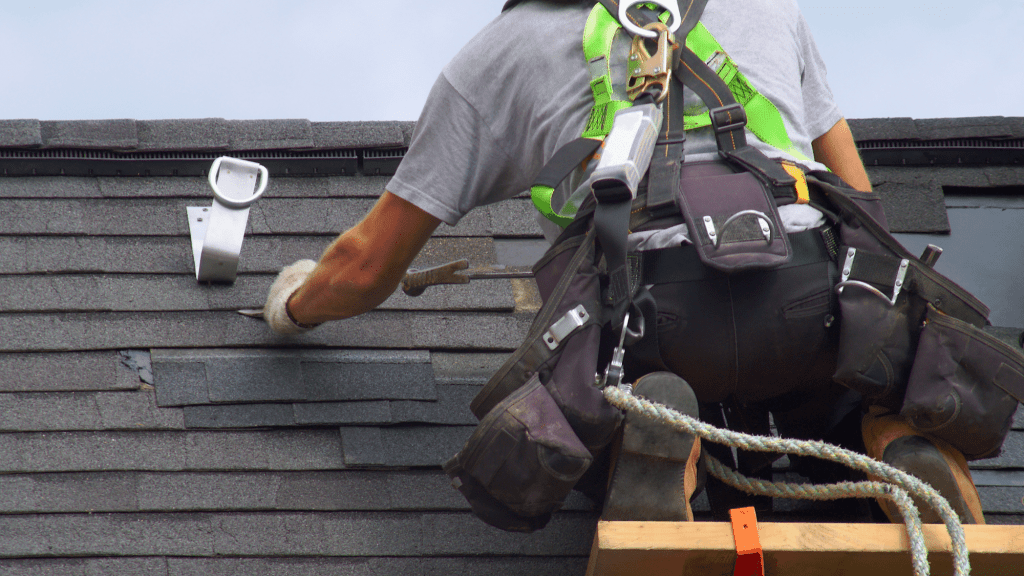
Safeguarding your home from the financial impact of weather-related roof damage, insurance offers a crucial safety net. Yet, to truly fortify your defense against costly repairs, it’s essential to adopt preventive strategies. Regular inspections, proper ventilation, and effective waterproofing emerge as key players in maintaining your roof’s robust condition. By incorporating these measures, you not only reduce the risk of weather-related damage but also enhance the longevity of your roofing structure.
Routine Inspections
Regular roof inspections serve as an effective method to spot and tackle potential issues before they escalate into significant problems. Inspections should evaluate the roof for signs of:
- Deterioration
- Missing or damaged shingles
- Debris in the gutters
- Roof ponding
To ensure the longevity of your roof, it’s advisable to schedule routine inspections, ideally twice a year or more frequently in regions with harsh weather.
By taking a proactive approach to maintenance, you can catch minor issues before they become major problems, saving you money on potentially expensive repairs. Pine Ridge Roofing offers free roof inspections, providing a reliable and expert assessment of your roof’s condition. Don’t wait—call us now to schedule your inspection and protect your investment.
Proper Ventilation and Waterproofing
To prevent the damaging effects of moisture buildup, ice dams, and other weather-related concerns on your roof, it is crucial to prioritize proper ventilation and waterproofing. Key practices include:
- Maintaining good indoor air quality
- Implementing effective home ventilation
- Utilizing exhaust fans and air purifiers
- Installing a reliable ventilation system
- Ensuring the proper attachment of roof ventilation products.
Neglecting these aspects may lead to issues like moisture accumulation and ice dams, potentially resulting in costly repairs and replacements. By prioritizing adequate roof ventilation and waterproofing, you can significantly reduce the risk of damage and extend the performance and lifespan of your roofing materials.
Pine Ridge Roofing: Your Partner in Roof Repair and Insurance Claims
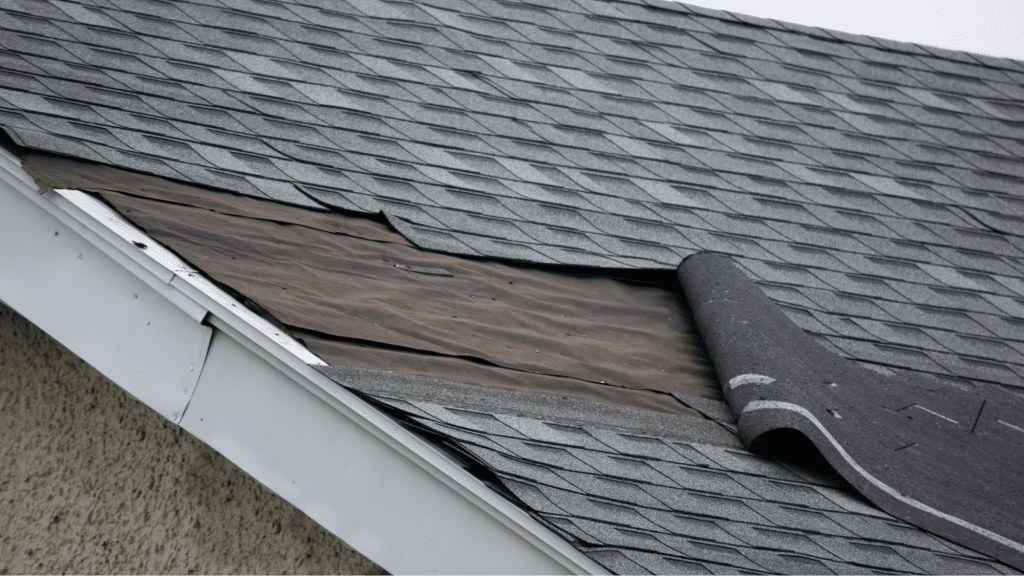
Pine Ridge Roofing, serving East Liberty, OH and surrounding areas, specializes in:
- Storm damage repairs
- Insurance claims
- Emergency inspection
- Tarping services
- Assistance with insurance claims for weather-related roof damage
- Roof replacements
- Siding repair and replacement
- Gutter repair and replacement
- Leaf Guard Installation
- Deck building
With over 25 years of combined experience, our team of certified roofers and insurance specialists is dedicated to delivering top-notch roof repairs and ensuring your home is protected and restored after a weather-related damage event.
Emergency Inspection and Tarping Services
If you suspect roof damage, reaching out to Pine Ridge Roofing for a complimentary emergency inspection is essential. This inspection assists in evaluating the extent of the damage, guiding decisions on necessary repairs or replacements. Our team of experts meticulously examines your roof, pinpointing issues such as missing shingles, raised flashing, or cracked tiles that demand immediate attention.
Apart from emergency inspections, Pine Ridge Roofing provides the following services:
- Our tarping services offer temporary protection, preventing further damage to your roof.
- Take swift action by securing your roof with tarps to minimize the risk of additional damage.
- We ensure your home stays safe and secure throughout the insurance claim process.
Insurance Claim Assistance
Navigating the insurance claim process can be overwhelming, but Pine Ridge Roofing is here to help. They offer the following services:
- Assisting with insurance claims
- Representing homeowners
- Negotiating with insurance companies
- Providing quality roof replacement services
Count on Pine Ridge Roofing’s insurance claim expertise to secure the best possible outcome for your claim, allowing you to prioritize the safety and well-being of your family. Their comprehensive insurance claim assistance includes:
- emergency inspections
- tarping damaged areas
- representing homeowners during insurance adjuster meetings
- negotiating with insurance companies, and using top-notch products like Owens Corning shingles and synthetic felt for roof replacements.
Pine Ridge Roofing ensures that your roof repair or replacement is conducted with professionalism and efficiency, giving you peace of mind and the assurance that your home is safeguarded.
Summary
Dealing with the aftermath of weather-related roof damage in East Liberty, Ohio is a significant task for homeowners. Understanding the nature of the damage, successfully navigating insurance claims, and adopting preventative roof maintenance practices are pivotal. This guide imparts essential knowledge. With the expertise of Pine Ridge Roofing, a trusted contractor, you can confidently address weather-related roof damage, ensuring the protection of your home and loved ones.
Frequently Asked Questions
Does Home Insurance Cover Roof Storm Damage?
Home insurance policies vary in their coverage of roof storm damage, contingent on the terms outlined in your specific plan. Most insurance plans typically include protection for damages inflicted by hail, strong winds, destruction from falling objects, and internal harm caused by roof storm damage. To illustrate, if a storm results in your roof’s destruction and subsequent rainwater damage to the ceiling, your insurance policy is likely to cover the necessary repairs for both the roof and ceiling.
Are blown-off shingles covered by insurance?
Insurance companies typically understand the importance of a roof and will cover the cost of roof replacement when shingles are blown off due to unpreventable circumstances.
What is considered wind damage to shingles?
Shingle damage resulting from wind is commonly identified by tearing, creasing, or detachment from the roof’s structure. This susceptibility is more pronounced in three-tab shingles, primarily due to the repetitive lifting or flapping they experience. It’s essential to recognize that unsealed shingles typically remain unaffected unless there is evident physical mat damage.
My roof doesn’t leak. Does this mean my roof is okay?
Just because your roof doesn’t exhibit leaks, it doesn’t necessarily indicate that your roof is in perfect condition. In numerous instances, roof damage isn’t immediately visible, and leaks might not manifest during the next rainfall. Concealed damage can persist unnoticed for an extended period. Skilled roofing professionals, as we have at Pine Ridge Roofing, possess tools and techniques that enable them to identify moisture beneath roofing materials and identify areas of damage that might otherwise go unnoticed. Schedule your free inspection now!
What is the most common roof damage?
Leaking roofs are the most common roof damage in East Liberty OH, often caused by broken shingles, and improper flashing near the chimney or gutters, and around vents or pipes.
